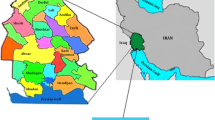Abstract
A 14 years old female Asiatic elephant was presented to the hospital with a history of mucoid watery diarrhea, inappetence and lethargy. Clinical examination revealed normal body temperature (98.2 °F), tachycardia (42 bpm), eupnoea (14/min), congested mucous membrane and dehydration. Haemato-biochemical parameters are well within the range. Microscopic examination of faecal sample revealed presence of live, motile and pear shaped ciliated Balantidium coli protozoa. Based on clinical and laboratory examination, the condition was diagnosed as balantidiasis. The animal was treated with Tab. Metronidazole (10 mg/Kg, PO, BID) for 5 days. Supportive treatment was done with antacids, hepatoprotectants and multivitamin supplements. An uneventful recovery was noticed after 5 days of treatment.

Similar content being viewed by others
Abbreviations
- B. coli :
-
Balantidium coli
- bpm:
-
Beats per minute
- E. coli :
-
Escherichia coli
- GIT:
-
Gastro-intestinal tract
References
Bauri RK, Ranjan R, Deb AR, Ranjan R (2012) Prevalence and sustainable control of Balantidium coli infection in pigs of Ranchi, Jharkhand, India. Vet World 5(2):94–99
Bilal CQ, Khan MS, Avais M, Ijaz M, Khan JA (2009) Prevalence and chemotherapy of Balantidium coli in cattle in the River Ravi region, Lahore (Pakistan). Vet Parasitol 163(1–2):15–17
Hassan N, Randhawa CS, Singh S, Narang D (2017) Chronic diarrhea and therapeutic trial with metronidazole in Balantidium coli infected cattle and buffaloes. IJLR 7(7):4–81
Ichhupujani RL, Bhatia R (1994) Medical parasitology. Jaypee Brothers Medical Publishers, India, pp 113–116
Islam MR, Haque AKMF, Khan MAHNA, Talukder MRI (2000) Balantidiasis in water buffaloes: incidences and therapeutics trial. Bangladesh J Agr Sci 27(1):143–146
Jain NC (1986) Schalm’s veterinary hematology, 4th edn. Lea and Febiger, Philadelphia
Klinhom S, Loythong J, Thitaram C (2017) Hematologic and biochemical reference intervals for captive Asian elephants (Elephas maximus) in Thailand. Kafkas Univ Vet Fak Derg 23(4):665–668
Mehlhorn H (2016) Balantidium coli. In: Mehlhorn H (ed) Encyclopedia of parasitology. Springer, Berlin
Needham CD, Simpson RG (1952) The benzidine test for occult blood in faeces. QJM Int J Med 21(2):123–134
Palanivel KM, Thangathurai R, Nedunchellian S (2005) Epizootiology of Balantidium coli infection in ruminants. Indian Vet J 82(6):682–683
Partani AK, Kumar D, Bhan AK (1998) Prevalence of Balantidium coli infection in camels in Bikaner, Rajasthan. J Vet Parasitol 12:118–121
Patil NA, Udupa KG, Kumar SP (1998) Prevalence, clinical symptoms and treatment of balantidiosis in buffaloes. Buffalo Bull 17:61–64
Raether W, Hanel H (2003) Nitro heterocyclic drugs with broad spectrum activity. Aventis Pharma AG, Germany 90:19–39
Rahman MM, Samad MA (2010) Prevalence of subclinical gastro-intestinal parasitosis and their effects on milk production with therapeutic management in red Chittagong cattle. Bangladesh J Vet Med 8(1):11–16
Randhawa SNS, Singla LD, Randhawa CS (2010) Chronic cattle diarrhea due to Balantidium coli infection-a clinical report. J Vet Parasitol 24:197–198
Reddy KP, Reddy LR (1993) Flagyl in treatment of balantidiosis. Livest Advis 18:32
Ryan SJ, Brashares JS, Walsh C, Milbers K, Kilroy C, Chapman CA (2012) A survey of gastrointestinal parasites of olive baboons (Papio anubis) in human settlement areas of Mole National Park, Ghana. J Parasitol 98(4):885–888
Sampurna R (2007) Balantidiosis (Balantidium coli). Department of Histopathology, Lady Hardinge Medical College, New Delhi, India
Schuster FL, Ramirez-Avila L (2008) Current world status of Balantidium coli. Clin Microbiol Rev 21(4):626–638
Silva ID, Kuruwita VY (1993) Hematology, plasma, and serum biochemistry values in domesticated elephants (Elephas maximus ceylonicus) in Sri Lanka. J Zoo Wildl Med 24:440–444
Singh NK, Singh H, Haque M, Rath SS (2012) Prevalence of parasitic infections in cattle of Ludhiana district, Punjab. J Parasit Dis 36(2):256–259
Smith DS (2003) Parasites and pestilence: infectious public health challenges. http://www.stanford.edu/class/humanbiol03/ParaSites2003/. Accessed Aug 2018
Solaymani-Mohammadi S, Petri WA (2006) Zoonotic implications of the swine-transmitted protozoal infections. Vet Parasitol 140:189–203
Sudan V, Sharma RL, Patya A, Singh PK (2012) An occurrence of clinical balantidiasis in a cross bred cow and its therapeutic management. J Vet Parasitol 26(2):164–166
Tajik J, Fard SRN (2013) Balantidiasis in a dromedarian camel. Asian Pac J Trop Dis 3(5):409–412
Author information
Authors and Affiliations
Contributions
Manuscript was written by NT as well contributed in disease diagnosis. SR had attended the case and sent samples for diagnosis. CGE contributed in disease diagnosis, management and review part. MK contributed in disease diagnosis and management.
Corresponding author
Ethics declarations
Conflict of interest
The authors declare no conflict of interest.
Additional information
Publisher's Note
Springer Nature remains neutral with regard to jurisdictional claims in published maps and institutional affiliations.
Rights and permissions
About this article
Cite this article
Thakur, N., Suresh, R., Chethan, G.E. et al. Balantidiasis in an Asiatic elephant and its therapeutic management. J Parasit Dis 43, 186–189 (2019). https://doi.org/10.1007/s12639-018-1072-1
Received:
Accepted:
Published:
Issue Date:
DOI: https://doi.org/10.1007/s12639-018-1072-1




